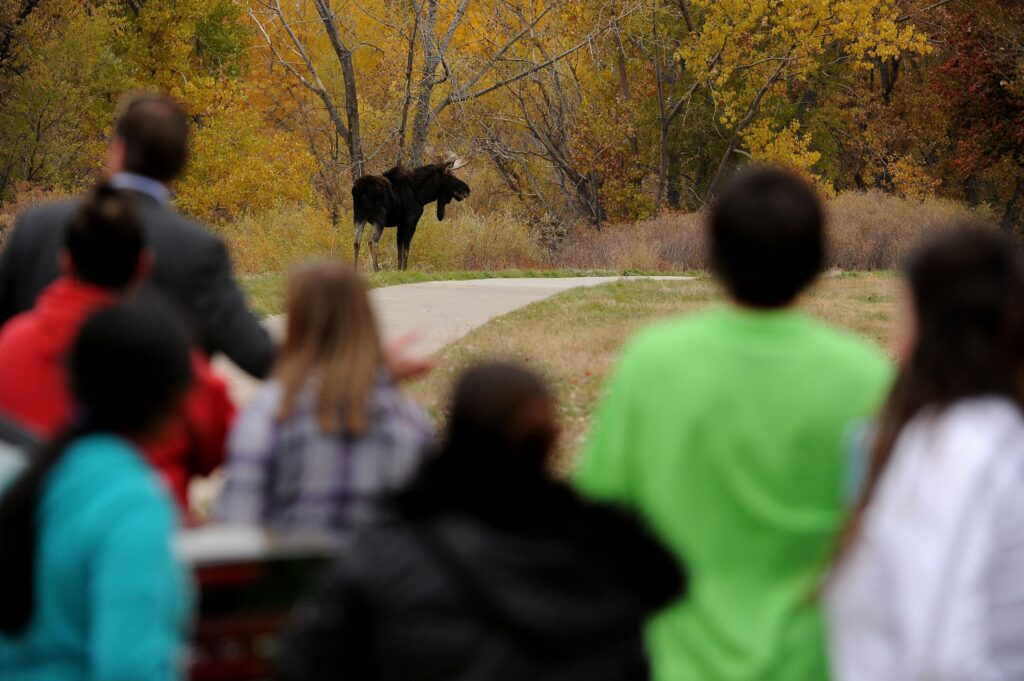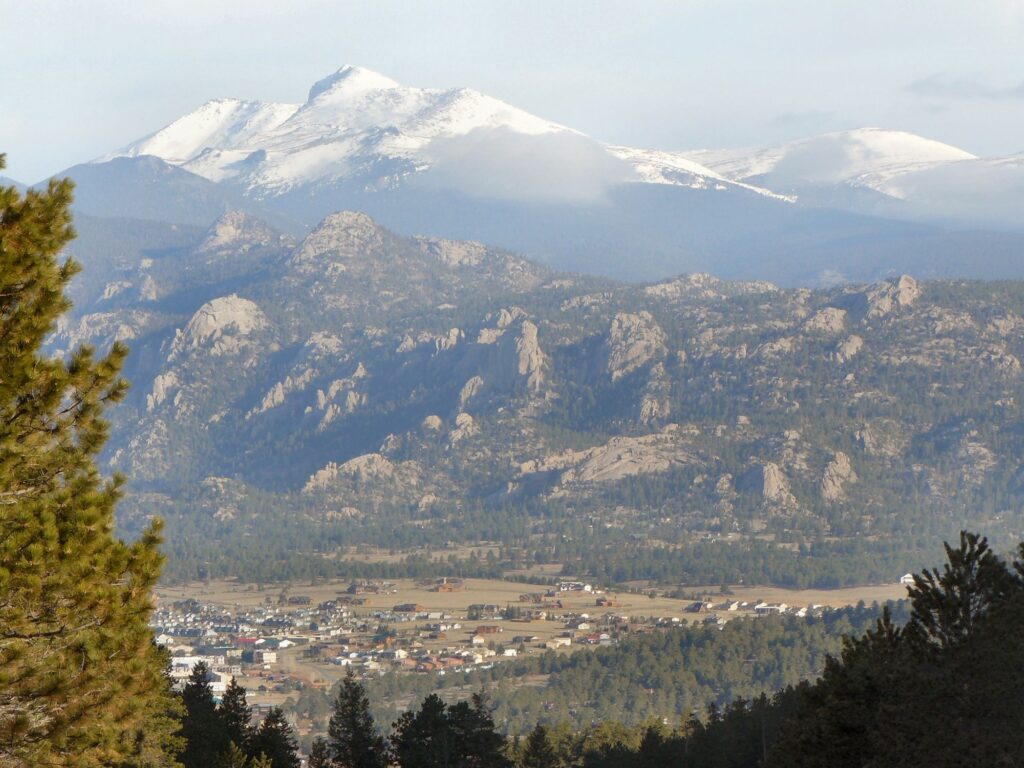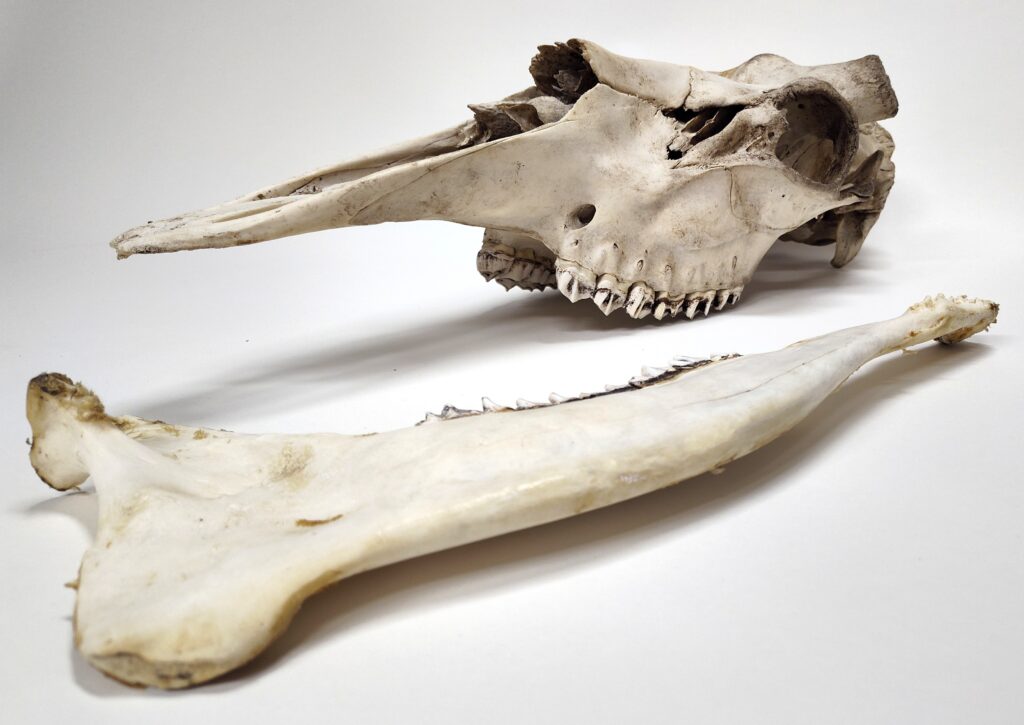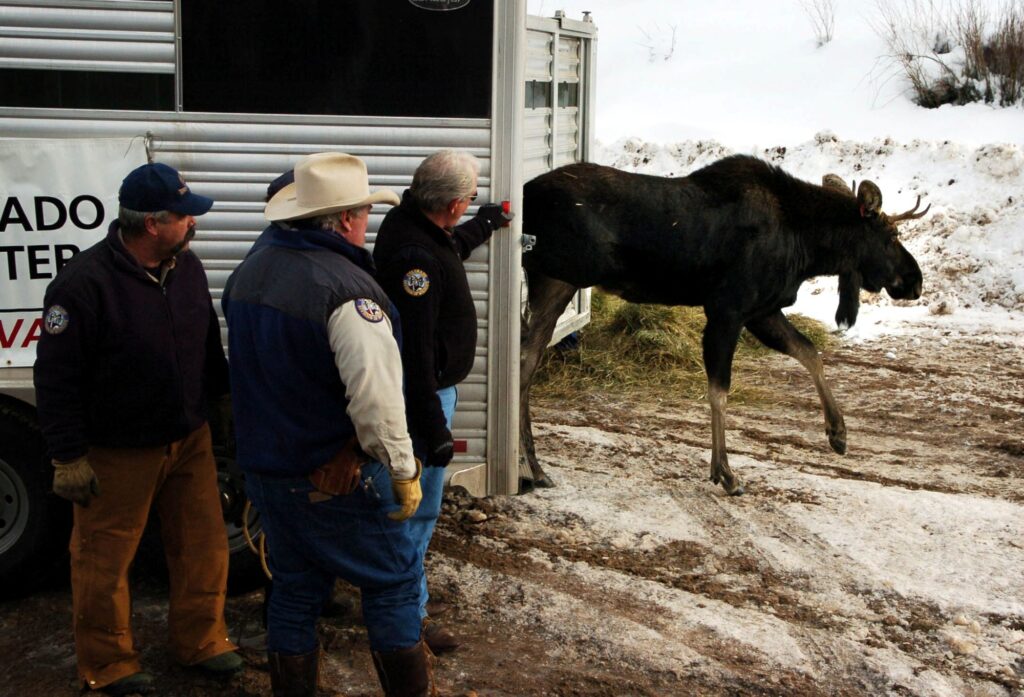Do Moose “Belong” in Colorado?
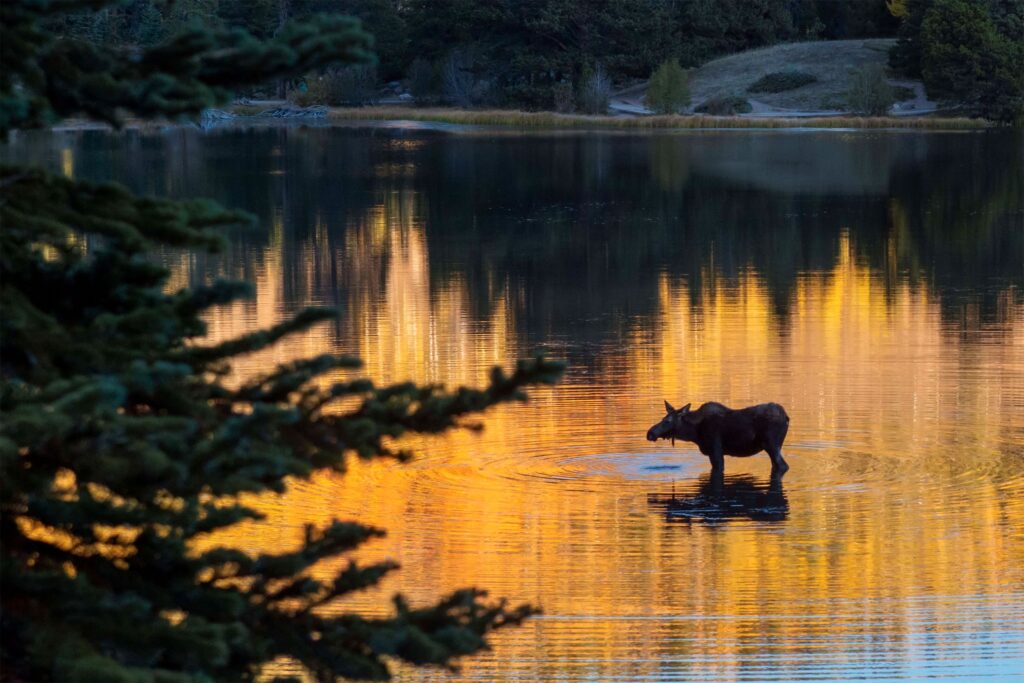
Along the twisting roads of Rocky Mountain National Park, visitors periodically encounter a unique type of traffic jam. Tourists park perilously close to steep roadsides, standing on the asphalt with heavy digital cameras and phones, and aiming their lenses at a nearby critter. They might anticipate a glimpse of a black bear with cubs, a herd of bighorn sheep, or a bull elk with his harem. These days, though, more and more travelers find themselves face to face with a moose.
Mostly absent from Colorado in the mid-20th century, moose were introduced by state wildlife officials into northern and western Colorado in a series of relocations between 1978 and 2012. Today more than 3,000 moose live in the state, and sightings are regularly reported as far south as New Mexico.
As moose populations in the Southern Rockies have risen, so have vehicle collisions and encounters between humans and moose, which are usually positive but can sometimes turn dangerous, particularly if moose are provoked. In addition, many people have raised concerns about these massive herbivores’ impacts on vegetation. Moose often depend on wetlands and riparian areas for food such as willows. The loss of these trees and shrubs can have a ripple effect on beavers and other species, and on sensitive landscapes.
These trends are causing some wildlife officials to rethink their approach to moose management and ask: Are moose invasive?
So far, the default answer given in public discourse, particularly from park and wildlife officials, has been “yes.” As a recent piece in Smithsonian magazine put it, although “the animals appear in a few scattered accounts from settlers in the mid-1800s,” officials “generally agree that Colorado never supported a breeding population.” In the past, similar arguments have been offered for moose living Wyoming and Idaho. But the basis of this view is not especially clear.
As archaeologists, historical ecologists, and paleoecologists, we study the long-term history of human and nonhuman animal relationships. This research requires thinking about ecological questions on timelines that span centuries to millennia, longer than is standard in some other areas of science. Studying the deep past means puzzling together various pieces of evidence—including historical records, archaeological materials, and paleoenvironmental proxies—to understand how animal communities change.
This panoramic perspective is often necessary for designing effective management programs in increasingly threatened ecosystems, whether for moose in Colorado or other species around the world.
EXAMINING THE COMPLICATED HISTORY OF MOOSE MIGRATIONS
Moose have certainly seen their fair share of ecological change. Adapted to colder climates and mountain wetlands, these mostly solitary herbivores originally evolved in Eurasia before migrating to North America during the end of the last ice age, about 15,000 years ago. But where they’ve lived, and when, since arriving on the continent is somewhat of a mystery.
Although written records mention moose in Colorado before the 20th century, the ecological significance of these observations is often dismissed. Milton Estes, an early settler of what became the town of Estes Park, recorded an encounter with a moose in the 1860s. After shooting the moose, Estes wrote that the animal wandered in from “the north country” and that it was the “first and only moose” to have been killed that far south.
Moose are capable of impressive long-distance journeys. Young males are especially apt to roam hundreds of miles in search of habitat and mates.
However, while anecdotes like this one are an important indicator of the historic presence of moose in the landscape, they are an unreliable method for assessing more nuanced ecological parameters such as ancient population size or breeding status in a particular locale. Even prolific early Euro-American chroniclers, like Estes, probably did not understand the larger biological context at play in the Rockies. By the time of his writing, the region had already experienced decades of significant colonial disruptions to native ecosystems.
There’s also the problem of rarity. Most human-wildlife encounters were not documented on paper. And prior to extensive colonial migrations in the mid-19th century, many areas of the Rockies had few European-descent visitors who wrote accounts of their interactions with animals.
Under normal conditions, moose live in low population densities. As a result, humans most likely rarely happened upon the animals during those decades, even in areas where they were well-established. In absolute terms, the number of moose mentions in early written records may be a better measure of the quantity of European settlers with a notebook than of the true number of resident moose.
Yet a critical look at these historic records shows that moose sightings in what eventually became Colorado were not quite as rare as Estes and others inferred. In fact, a World War II–era summary noted records of moose in different corners of the Southern Rocky Mountains in 1871, 1887, 1933, and 1941. Certainly, it’s possible that each of these mentions represented isolated observations of roving bachelor moose. But even if so, they demonstrate the persistent low-level presence of moose in many areas of the Colorado Rockies over the last 150 years. And in the 1940s, at least some biologists viewed moose as a native taxon that had recently been extirpated.
WHAT ARCHAEOLOGICAL EVIDENCE REVEALS
Whether these historic sightings of moose in Colorado were “one-off” brushes with wandering individuals or chance meetings with permanent but small populations is a question that should be answered with appropriate scientific data—not the musings of colonial diarists.
When examining historical records, scientists and conservation decision-makers should be especially careful not to trust 19th-century colonial authors’ inferences about Native people’s knowledge. A glaring example can be seen in the aforementioned Smithsonian article, which recounted a dubious secondhand anecdote about a Shoshone man in Wyoming’s Wind River range who had supposedly never heard of a moose. While the source of this anecdote is not clear, it conflicts with ethnohistoric accounts that document Shoshone moose hunts in the Wind River range during the 1800s.
As recent archaeological scholarship demonstrates, Euro-American historic records are often wrong about relationships between Indigenous people and animals. Native perspectives should come directly from Native peoples, particularly in important discussions like this one.
Colorado likely boasted many areas of suitable moose habitat since the animals first set foot in North America 15,000 years ago. Ideally, researchers would turn to the fossil record to assess whether moose have roamed throughout the region during this extended time span.
But doing so is not a simple matter. In the fossil record, absence of evidence is not evidence of absence.
Colorado has few facilities where experts can identify mammal species based on their bones. Furthermore, specialists have not analyzed many ancient assemblages of animal bone in a way that might clearly distinguish moose from other related taxa such as elk.
Despite these constraints, the archaeozoological record provides some clues that point toward a deeper history of moose in the region. Moose bones are found in archaeological materials from the Jurgens site—a 9,000-year-old assemblage near Greeley in northern Colorado that is connected to ancient Indigenous peoples.
These limited data suggest moose have been a natural part of the region for thousands of years, and that there is much more to learn about their ancient role in the area.
DESIGNING EVIDENCE-BASED MOOSE MANAGEMENT
Acknowledging that moose have a long-standing, or at least recurring, ecological niche in the Southern Rockies has important implications for wildlife management. The scientific record suggests that managers should not define and exclude moose as invaders. Rather, they should develop nuanced approaches in tandem with Indigenous stakeholders who recognize the complex ancient history of moose in the Southern Rocky Mountains. These strategies might include keeping moose populations in check by returning predators to the region and restoring Indigenous hunting access.
However, no matter which approaches are taken, the future likely won’t look much like the past, even in protected areas. Rocky Mountain ecosystems have been deeply altered by a host of factors—most significantly, the forced removal of Indigenous people and their management systems, along with the loss of natural predators, shifts in land use, habitat fragmentation, fire suppression, and climate change. Many of the processes driving ecological change are accelerating.
Addressing these issues will require thoughtful interventions and difficult decisions. To make effective management and conservation choices, decision-makers need a clear-headed understanding of the moose’s ecological role over deeper timescales, the animal’s current and ancient relationships with Indigenous peoples in the region, and Colorado’s rapidly changing landscapes.
These issues are not unique to moose. In conservation areas and rewilding sites across the globe, people are grappling with whether various species are “invasive.” Around the world, affected people are assessing ancient animal distributions, debating how to assess whether a modern species belongs in an area, and thinking over plans for the future.
The case of Southern Rocky Mountain moose shows how difficult it can be to find simple answers to these questions. This case also illustrates the importance of taking a thoughtful approach to conservation issues that considers the complexities of deep history and multiple stakeholders, including Indigenous peoples, wildlife officials, local residents, and the animals themselves.

























